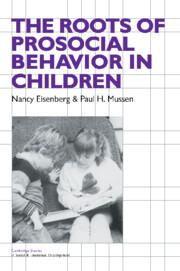Book contents
- Frontmatter
- Contents
- Preface
- 1 Introduction
- 2 Methodological and theoretical considerations in the study of prosocial behavior
- 3 Biology and prosocial behavior
- 4 Culture and prosocial behavior
- 5 “Person” variables and prosocial behavior
- 6 Socialization in the family
- 7 Socialization by agents outside the family
- 8 Cognition, role taking, interpersonal problem solving, and moral judgment
- 9 Emotional factors in prosocial behavior
- 10 Situational determinants
- 11 Conclusions
- References
- Name index
- Subject index
10 - Situational determinants
Published online by Cambridge University Press: 31 December 2009
- Frontmatter
- Contents
- Preface
- 1 Introduction
- 2 Methodological and theoretical considerations in the study of prosocial behavior
- 3 Biology and prosocial behavior
- 4 Culture and prosocial behavior
- 5 “Person” variables and prosocial behavior
- 6 Socialization in the family
- 7 Socialization by agents outside the family
- 8 Cognition, role taking, interpersonal problem solving, and moral judgment
- 9 Emotional factors in prosocial behavior
- 10 Situational determinants
- 11 Conclusions
- References
- Name index
- Subject index
Summary
Almost all behavior, including moral behavior, is a function of the interaction between the characteristics of the individual - personality traits, motives, needs, and physical and cognitive abilities - and features of the specific situation or circumstances (Krebs & Miller, 1985; Kurtines, 1984, 1986; Staub, 1978). On the one hand, the stability of prosocial behavior over time and across situations is believed to be the product of enduring characteristics or predispositions of the individual. On the other hand, it is obvious that our reactions are affected by transitory feelings (such as moods), features of the immediate situation (environmental circumstances), and events that “just happen.”
The term situational determinants is used to designate at least two kinds of influences: (1) striking, unique events that radically alter an individuals' personality, life-style, or propensities toward various patterns of behavior; (2) temporary external conditions (such as suddenly encountering a bloody, injured child) and singular (or seldom repeated) experiences or transient moods and emotions. Even casual observation attests that such situational determinants often elicit or deter the expression of prosocial tendencies. Variations in the individual's behavior from time to time or from situation to situation can be understood only by examining the role of the immediate context. Even the most selfish are likely to assist an elderly companion who has tripped or help a screaming toddler who is in danger of drowning in shallow water.
- Type
- Chapter
- Information
- The Roots of Prosocial Behavior in Children , pp. 140 - 149Publisher: Cambridge University PressPrint publication year: 1989

